Impacts of Indigenous Cultural Burning Versus Hazard Reduction on Dry Sclerophyll Forest Composition, Abundance, and Species Richness in Southeast Australia
Abstract
1. Introduction
2. Materials and Methods
2.1. Fieldwork
2.2. Statistical Analysis
3. Results
4. Discussion
5. Conclusions
Supplementary Materials
Author Contributions
Funding
Institutional Review Board Statement
Informed Consent Statement
Data Availability Statement
Acknowledgments
Conflicts of Interest
References
- Bowman, D. Australian landscape burning: A continental and evolutionary perspective. In Fire in Ecosystems of South-West Western Australia: Impacts and Management; Burrows, N.D., Abbott, I., Eds.; Backhuys Publishers: Leiden, The Netherlands, 2003; pp. 107–118. [Google Scholar]
- Miller, B.P.; Murphy, B.P. Fire and Australian vegetation. In Australian Vegetation; Keith, D., Ed.; Cambridge University Press: Cambridge, UK, 2017; pp. 113–134. [Google Scholar]
- Gill, A.M. Fire and the Australian flora: A review. Aust. For. 1975, 38, 4–25. [Google Scholar] [CrossRef]
- Gill, A.M.; Bradstock, R. Fire regimes and biodiversity: A set of postulates. In Australia Burning: Fire Ecology, Policy and Management Issues; CSIRO Publishing: Clayton, NSW, Australia, 2003. [Google Scholar]
- Keith, D.A. Ocean Shores to Desert Dunes: The Native Vegetation of New South Wales and the ACT; Department of Environment and Conservation (NSW): Hurstville, NSW, Australia, 2004. [Google Scholar]
- Keith, D.A. Functional traits: Their roles in understanding and predicting biotic responses to fire regimes from individuals to landscapes. In Flammable Australia: Fire Regimes, Biodiversity and Ecosystems in a Changing World; CSIRO Publishing: Clayton, NSW, Australia, 2012; pp. 97–125. [Google Scholar]
- Gill, A.M. Bushfires and biodiversity in southern Australian forests. In Flammable Australia; Bradstock, R., Gill, A.M., Williams, R.J., Eds.; CSIRO Publishing: Collingwood, VIC, Australia, 2012; pp. 235–252. [Google Scholar]
- Ens, E.; Walsh, F.; Clarke, P. Aboriginal people and Australia’s vegetation: Past and current interactions. In Australian Vegetation; Cambridge University Press: Cambridge, UK, 2017; pp. 89–112. [Google Scholar]
- Fletcher, M.-S.; Hall, T.; Alexandra, A.N. The loss of an indigenous constructed landscape following British invasion of Australia: An insight into the deep human imprint on the Australian landscape. Ambio 2021, 50, 138–149. [Google Scholar] [CrossRef]
- Clarkson, C.; Jacobs, Z.; Marwick, B.; Fullagar, R.; Wallis, L.; Smith, M.; Roberts, R.G.; Hayes, E.; Lowe, K.; Carah, X.; et al. Human occupation of northern Australia by 65,000 years ago. Nature 2017, 547, 306–310. [Google Scholar] [CrossRef]
- Mariani, M.; Connor, S.E.; Theuerkauf, M.; Herbert, A.; Kuneš, P.; Bowman, D.; Fletcher, M.S.; Head, L.; Kershaw, A.P.; Haberle, S.G. Disruption of cultural burning promotes shrub encroachment and unprecedented wildfires. Front. Ecol. Environ. 2022, 20, 292–300. [Google Scholar] [CrossRef]
- McKemey, M.B.; Costello, O.; Ridges, M.; Ens, E.J.; Hunter, J.T.; Reid, N.C.H. A review of contemporary Indigenous cultural fire management literature in southeast Australia. EcoEvoRxiv 2020. [Google Scholar] [CrossRef]
- Steffensen, V. Fire Country: How Indigenous Fire Management Could Help Save Australia; Hardie Grant Travel: Richmond, VIC, Australia, 2020. [Google Scholar]
- Russell-Smith, J.; Whitehead, P.J.; Cooke, P. (Eds.) Culture, Ecology and Economy of Fire Management in North Australian Savannas: Rekindling the Wurrk Tradit; CSIRO Publishing: Clayton, NSW, Australia, 2009. [Google Scholar]
- Fletcher, M.-S.; Romano, A.; Connor, S.; Mariani, M.; Maezumi, S.Y. Catastrophic Bushfires, Indigenous Fire Knowledge and Reframing Science in Southeast Australia. Fire 2021, 4, 61. [Google Scholar] [CrossRef]
- David, B.; Fletcher, M.-S.; Connor, S.; Pullin, V.R.; Birkett-Rees, J.; Delannoy, J.-J.; Mariani, M.; Romano, A.; Maezumi, S.Y. Cultural Burning; Cambridge University Press: Cambridge, UK, 2024. [Google Scholar] [CrossRef]
- Neale, T.; Carter, R.; Nelson, T.; Bourke, M. Walking together: A decolonising experiment in bushfire management on Dja Dja Wurrung country. Cult. Geogr. 2019, 26, 341–359. [Google Scholar] [CrossRef]
- Ngurra, D.; Dadd, L.; Glass, P.; Scott, R.; Graham, M.; Judge, S.; Hodge, P.; Suchet-Pearson, S. Yanama budyari gumada: Reframing the urban to care as Darug Country in western Sydney. Aust. Geogr. 2019, 50, 279–293. [Google Scholar] [CrossRef]
- Weir, J.; Freeman, D. Fire in the South: A Crosscontinental Exchange; Bushfire and Natural Hazards CRC: Canberra, ACT, Australia, 2019. [Google Scholar]
- Smith, W.; Weir, J.; Neale, T. Southeast Australia Aboriginal Fire Forum; Bushfire and Natural Hazards CRC: Melbourne, VIC, Australia, 2018. [Google Scholar]
- Rey, J.A.; Norman, C.W.; Brennan, G.; Ens, E.; Norman-Hill, R. ‘Burning Love’, Living Ngurra: Healing Country, Healing Hearts and Sharing Minds in Dharug Country. J. Glob. Indig. 2025, 9, 138509. [Google Scholar] [CrossRef]
- Pascoe, J.; Shanks, M.; Pascoe, B.; Clarke, J.; Goolmeer, T.; Moggridge, B.; Williamson, B.; Miller, M.; Costello, O.; Fletcher, M.-S. Lighting a pathway: Our obligation to culture and Country. Ecol. Manag. Restor. 2023, 24, 153–155. [Google Scholar] [CrossRef]
- Dharug, N.; Dadd, L.; Norman, C.; Scott, R.; Tynan, L.; Graham, M.; Suchet-Pearson, S.; Narwal, H.; Lemire, J. Biyani Guwiyang Dharug Ngurrawa: Healing fire on Dharug Country. Ecosyst. People 2025, 21, 2495016. [Google Scholar] [CrossRef]
- Maclean, K.; Robinson, C.J.; Costello, O. (Eds.) A National Framework to Report on the Benefits of Indigenous Cultural Fire Management; CSIRO: Clayton, VIC, Australia, 2018. [Google Scholar]
- Spurway, K. Critical reflections on Indigenous peoples’ ecological knowledge and disaster risk management in Australia: A rapid evidence review. Glob. Media J. Aust. Ed. 2018, 12, 1–16. [Google Scholar]
- Kerr, A. To Burn or Not to Burn: Perceptions of Fire Management Around Australia; Macotropic Trust: Sydney, NSW, Australia, 2019. [Google Scholar]
- Eriksen, C.; Hankins, D.L. The Retention, Revival, and Subjugation of Indigenous Fire Knowledge through Agency Fire Fighting in Eastern Australia and California. Soc. Nat. Resour. 2014, 27, 1288–1303. [Google Scholar] [CrossRef]
- Lehman, G. Turning back the clock: Fire, biodiversity, and Indigenous community development in Tasmania. In Working on Country: Contemporary Indigenous Management of Australia’s Lands and Coastal Regions; Baker, R.M., Davies, J., Young, E.A., Eds.; Oxford University Press: South Melbourne, VIC, Australia, 2001; pp. 308–319. [Google Scholar]
- Robinson, C.; Barber, M.; Hill, R.; Gerrard, E.; James, G. Protocols for Indigenous Fire Management Partnerships; CSIRO: Brisbane, QLD, Australia, 2016. [Google Scholar]
- Bardsley, D.K.; Prowse, T.A.; Siegfriedt, C. Seeking knowledge of traditional Indigenous burning practices to inform regional bushfire management. Local Environ. 2019, 24, 727–745. [Google Scholar] [CrossRef]
- Weir, J.K.; Sutton, S.; Catt, G. The Theory/Practice of Disaster Justice: Learning from Indigenous Peoples’ Fire Management. In Natural Hazards and Disaster Justice: Challenges for Australia and Its Neighbours; Lukasiewicz, A., Baldwin, C., Eds.; Springer: Singapore, 2020; pp. 299–317. [Google Scholar]
- McKemey, M.; Banbai Rangers; Patterson, M.; Hunter, J.T.; Ridges, M.; Ens, E.; Miller, C.; Costello, O.; Reid, N.C.H. Indigenous cultural burning had less impact than wildfire on old-growth, threatened Backwater grevillea (Grevillea scortechinii subsp. sarmentosa) while effectively decreasing fuel loads. Int. J. Wildland Fire 2021, 30, 745–756. [Google Scholar] [CrossRef]
- Robertson, G. Ngulla Firesticks cultural burning. J. Aust. Nativ. Plants Soc. 2019, 20, 7–8. [Google Scholar]
- Lindenmayer, D. Indigenous land and fire management: A discussion summary. In Australia Burning: Fire Ecology, Policy and Management Issues; Cary, G., Lindenmayer, D., Dovers, S., Eds.; CSIRO Publishing: Collingwood, VIC, Australia, 2003; pp. 224–226. [Google Scholar]
- Firesticks Alliance. Submission to the Royal Commission into National Natural Disaster Arrangements; Unpublished; Firesticks Alliance Indigenous Corporation: Banyo, QLD, Australia, 2020; Available online: https://firesticks.org.au/ (accessed on 10 October 2020).
- Bowd, E.J.; Cary, G.J.; Freeman, D.; Bell-Garner, B.; Lindenmayer, D. Plant Responses to a Re-emergence of Cultural Burning in Long-Unburnt, Threatened Temperate Woodlands. Glob. Change Biol. 2025, 31, e70230. [Google Scholar] [CrossRef]
- McKemey, M.B.; Patterson, M.; Rangers, B.; Ens, E.J.; Reid, N.C.H.; Hunter, J.T.; Costello, O.; Ridges, M.; Miller, C. Cross-Cultural Monitoring of a Cultural Keystone Species Informs Revival of Indigenous Burning of Country in South-Eastern Australia. Hum. Ecol. 2019, 47, 893–904. [Google Scholar] [CrossRef]
- McKemey, M.B.; Banbai Rangers; Ens, E.J.; Hunter, J.T.; Ridges, M.; Costello, O.; Reid, N.C.H. Co-producing a fire and seasons calendar to support renewed Indigenous cultural fire management. Austral Ecol. 2021, 46, 1011–1029. [Google Scholar] [CrossRef]
- McKemey, M.; Banbai Nation. Winba = Fire. Banbai Fire and Seasons Calendar, Wattleridge Indigenous Protected Area; Firesticks Alliance: Sydney, NSW, Australia, 2020. [Google Scholar]
- Clarke, P.J. The Vegetated Landscape. In High Lean Country: Land, People and Memory in New England; Atkinson, A.T., Ryan, J.S., Davidson, I., Piper, A., Eds.; Allen & Unwin: Crows Nest, NSW, Australia, 2006; pp. 57–68. [Google Scholar]
- Graham, M.; Watson, P.; Tierney, D. Fire and the Vegetation of the Border Rivers-Gwydir Region; Nature Conservation Council: Sydney, NSW, Australia, 2014. [Google Scholar]
- Noble, I.R.; Slatyer, R. The use of vital attributes to predict successional changes in plant communities subject to recurrent disturbances. Vegetatio 1980, 43, 5–21. [Google Scholar] [CrossRef]
- Clarke, P.J.; Knox, K.J.; Campbell, M.L.; Copeland, L.M. Post-fire recovery of woody plants in the New England Tableland Bioregion. Cunninghamia 2009, 11, 221–239. [Google Scholar]
- Clarke, P.J.; Lawes, M.J.; Murphy, B.P.; Russell-Smith, J.; Nano, C.E.M.; Bradstock, R.; Enright, N.J.; Fontaine, J.B.; Gosper, C.R.; Radford, I.; et al. A synthesis of postfire recovery traits of woody plants in Australian ecosystems. Sci. Total Environ. 2015, 534, 31–42. [Google Scholar] [CrossRef]
- Gill, A. Adaptive responses of Australian vascular plant species to fires. In Fire and the Australian Biota; Gill, A.M., Groves, R.H., Noble, I.R., Eds.; Australian Academy of Science: Canberra, ACT, Australia, 1981; pp. 243–272. [Google Scholar]
- Hunter, J.T. Persistence on inselbergs: The role of obligate seeders and resprouters. J. Biogeogr. 2003, 30, 497–510. [Google Scholar] [CrossRef]
- Ooi, M.K.J.; Whelan, R.J.; Auld, T.D. Persistence of obligate-seeding species at the population scale: Effects of fire intensity, fire patchiness and long fire-free intervals. Int. J. Wildland Fire 2006, 15, 261–269. [Google Scholar] [CrossRef]
- Palmer, H.D.; Denham, A.J.; Ooi, M.K.J. Fire severity drives variation in post-fire recruitment and residual seed bank size of Acacia species. Plant Ecol. 2018, 219, 527–537. [Google Scholar] [CrossRef]
- Clarke, P.J.; Knox, K.J. Post-fire response of shrubs in the tablelands of eastern Australia: Do existing models explain habitat differences? Aust. J. Bot. 2002, 50, 53–62. [Google Scholar] [CrossRef]
- Pausas, J.G.; Keeley, J.E. Evolutionary ecology of resprouting and seeding in fire-prone ecosystems. New Phytol. 2014, 204, 55–65. [Google Scholar] [CrossRef]
- Pausas, J.G.; Bradstock, R.A. Fire persistence traits of plants along a productivity and disturbance gradient in mediterranean shrublands of south-east Australia. Glob. Ecol. Biogeogr. 2007, 16, 330–340. [Google Scholar] [CrossRef]
- Keith, D. Fire-driven extinction of plant populations: A synthesis of theory and review of evidence from Australian vegetation. Proc. Linn. Soc. New South Wales 1996, 116, 37–78. [Google Scholar]
- Kitchin, M.B. Fire Ecology and Fire Management for the Conservation of Plant Species and Vegetation Communities in a National Park in northern NSW, Australia. Ph.D. Thesis, University of New England, Armidale, NSW, Australia, 2001. [Google Scholar]
- Department of Planning Industry and Environment. Key Threatening Processes. Available online: https://www.environment.nsw.gov.au/topics/animals-and-plants/threatened-species/about-threatened-species/key-threatening-processes (accessed on 27 April 2020).
- Williams, J.E.; Gill, A.M. The Impact of Fire Regimes on Native Forests in Eastern New South Wales; NSW National Parks and Wildlife Service: Hurstville, NSW, Australia, 1995. [Google Scholar]
- Kenny, B.; Sutherland, E.; Tasker, E.; Bradstock, R. Guidelines for Ecologically Sustainable Fire Management; NSW National Parks and Wildlife Service: Sydney, NSW, Australia, 2004. [Google Scholar]
- McKemey, M.B.; Banbai Rangers; Yugul Mangi Rangers; Costello, O.; Hunter, J.T.; Ens, E.J. ‘Right-way’ science: Reflections on co-developing Indigenous and Western cross-cultural knowledge to support Indigenous cultural fire management. Ecol. Manag. Restor. 2022, 23, 75–82. [Google Scholar] [CrossRef]
- McKemey, M. Developing Cross-Cultural Knowledge (‘Right Way’ Science) to Support Indigenous Cultural Fire Management Doctoral. Ph.D. Thesis, University of New England, Armidale, NSW, Australia, 2020. [Google Scholar]
- The Victorian Traditional Owner Cultural Fire Knowledge Group. The Victorian Traditional Owner Cultural Fire Strategy; VTOCFKG: Melbourne, VIC, Australia, 2019. [Google Scholar]
- Underwood, A. Beyond BACI: Experimental designs for detecting human environmental impacts on temporal variations in natural populations. Mar. Freshw. Res. 1991, 42, 569–587. [Google Scholar] [CrossRef]
- Rural Fire Service NSW. NSW Rural Fire Service L2 Prescribed Burn Plan ‘Wattle Ridge’ Plot A and Plot B; Rural Fire Service NSW: Armidale, NSW, Australia, 2015. [Google Scholar]
- National Parks and Wildlife Service NSW. National Parks & Wildlife Service Level 2 Prescribed Burn Plan Glen-Warra-St Ives HR; NSW Government: Glen Innes, NSW, Australia, 2015. [Google Scholar]
- Hunter, J.T. Vegetation and floristics of Warra National Park and Wattleridge, Northern Tablelands, NSW. Cunninghamia 2005, 9, 255–274. [Google Scholar]
- Benson, J.; Ashby, E. Vegetation of the Guyra 1: 100 000 map sheet New England Bioregion, New South Wales. Cunninghamia 2000, 6, 747–872. [Google Scholar]
- Department of Environment Climate Change and Water. Operational Manual for BioMetric 3.1; NSW Government: Sydney, NSW, Australia, 2011. [Google Scholar]
- Keeley, J.E. Fire intensity, fire severity and burn severity: A brief review and suggested usage. Int. J. Wildland Fire 2009, 18, 116–126. [Google Scholar] [CrossRef]
- Hines, F.; Tolhurst, K.G.; Wilson, A.A.; McCarthy, G.J. Overall Fuel Hazard Assessment Guide; Victorian Government, Department of Sustainability and Environment: Melbourne, VIC, Australia, 2010. [Google Scholar]
- McStephen, M. Fire and Biodiversity Monitoring Manual; Country Fire Authority Victoria: Melbourne, VIC, Australia, 2014. [Google Scholar]
- Specht, R.L.; Morgan, D.G. The balance between the foliage projective covers of overstorey and understorey strata in Australian vegetation. Aust. J. Ecol. 1981, 6, 193–202. [Google Scholar] [CrossRef]
- Hunter, J.T. Vegetation & Flora of Wattleridge; J.A. Hunter Pty Ltd.: Invergowrie, NSW, Australia, 2003. [Google Scholar]
- Hunter, J.T. Vegetation and Floristics of Warra National Park; National Parks and Wildlife Service NSW: Invergowrie, NSW, Australia, 2001. [Google Scholar]
- National Herbarium of NSW. PlantNET (The NSW Plant Information Network System). Available online: https://plantnet.rbgsyd.nsw.gov.au/ (accessed on 18 September 2020).
- R Core Team. R: A Language and Environment for Statistical Computing. Available online: http://www.R-project.org/ (accessed on 16 October 2020).
- Hammer, O.; Harper, D.A.T.; Ryan, P.D. PAST: Palaeontological statistics software package for education and data analysis. Palaeontol. Electron. 2001, 4, 9. [Google Scholar]
- Tolhurst, K.G.; Flinn, D.W.; Loyn, R.H.; Wilson, A.; Foletta, I. Ecological Effects of Fuel Reduction Burning in a Dry Sclerophyll Forest; Forest Research Centre, Department of Conservation and Environment: Melbourne, VIC, Australia, 1992. [Google Scholar]
- Watson, P.; Wardell-Johnson, G. Fire frequency and time-since-fire effects on the open-forest and woodland flora of Girraween National Park, south-east Queensland, Australia. Austral Ecol. 2004, 29, 225–236. [Google Scholar] [CrossRef]
- Purdie, R.W.; Slatyer, R.O. Vegetation succession after fire in sclerophyll woodland communities in south-eastern Australia. Aust. J. Ecol. 1976, 1, 223–236. [Google Scholar] [CrossRef]
- Gosper, C.R.; Yates, C.J.; Prober, S.M. Floristic diversity in fire-sensitive eucalypt woodlands shows a ‘U’-shaped relationship with time since fire. J. Appl. Ecol. 2013, 50, 1187–1196. [Google Scholar] [CrossRef]
- Duff, T.J.; Bell, T.L.; York, A. Managing multiple species or communities? Considering variation in plant species abundances in response to fire interval, frequency and time since fire in a heathy Eucalyptus woodland. For. Ecol. Manag. 2013, 289, 393–403. [Google Scholar] [CrossRef]
- Chick, M.P.; Cohn, J.S.; Nitschke, C.R.; York, A. Lack of soil seedbank change with time since fire: Relevance to seed supply after prescribed burns. Int. J. Wildland Fire 2016, 25, 849–860. [Google Scholar] [CrossRef]
- Clarke, P.J.; Knox, K.J.; Wills, K.E.; Campbell, M. Landscape patterns of woody plant response to crown fire: Disturbance and productivity influence sprouting ability. J. Ecol. 2005, 93, 544–555. [Google Scholar] [CrossRef]
- Lamont, B.B.; Enright, N.J.; He, T. Fitness and evolution of resprouters in relation to fire. Plant Ecol. 2011, 212, 1945–1957. [Google Scholar] [CrossRef]
- Vesk, P.A.; Westoby, M. Sprouting ability across diverse disturbances and vegetation types worldwide. J. Ecol. 2004, 92, 310–320. [Google Scholar] [CrossRef]
- Bradstock, R.A.; O’Connell, M.A. Demography of woody plants in relation to fire: Banksia ericifolia L.f. and Petrophile pulchella (Schrad) R.Br. Aust. J. Ecol. 1988, 13, 505–518. [Google Scholar] [CrossRef]
- Morrison, D.A.; Cary, G.J.; Pengelly, S.M.; Ross, D.G.; Mullins, B.J.; Thomas, C.R.; Anderson, T.S. Effects of fire frequency on plant species composition of sandstone communities in the Sydney region: Inter-fire interval and time-since-fire. Aust. J. Ecol. 1995, 20, 239–247. [Google Scholar] [CrossRef]
- Penman, T.D.; Christie, F.J.; Andersen, A.N.; Bradstock, R.A.; Cary, G.J.; Henderson, M.K.; Price, O.; Tran, C.; Wardle, G.M.; Williams, R.J.; et al. Prescribed burning: How can it work to conserve the things we value? Int. J. Wildland Fire 2011, 20, 721–733. [Google Scholar] [CrossRef]
- Wintle, B.A.; Legge, S.; Woinarski, J.C. After the Megafires: What Next for Australian Wildlife? Trends Ecol. Evol. 2020, 35, 753–757. [Google Scholar] [CrossRef]
- Tolhurst, K.G.; McCarthy, G. Effect of prescribed burning on wildfire severity: A landscape-scale case study from the 2003 fires in Victoria. Aust. For. 2016, 79, 1–14. [Google Scholar] [CrossRef]
- Department of Planning Industry and Environment. Google Earth Engine Burnt Area Map (GEEBAM). Available online: https://datasets.seed.nsw.gov.au/dataset/google-earth-engine-burnt-area-map-geebam (accessed on 17 April 2020).
- Filkov, A.I.; Ngo, T.; Matthews, S.; Telfer, S.; Penman, T.D. Impact of Australia’s catastrophic 2019/20 bushfire season on communities and environment. Retrospective analysis and current trends. J. Saf. Sci. Resil. 2020, 1, 44–56. [Google Scholar] [CrossRef]
- Ens, E.J.; Turpin, G. Synthesis of Australian cross-cultural ecology featuring a decade of annual Indigenous ecological knowledge symposia at the Ecological Society of Australia conferences. Ecol. Manag. Restor. 2022, 23, 3–16. [Google Scholar] [CrossRef]
- Lilleyman, A.; Millar, G.; Burn, S.; Fatt, K.H.-L.; Talbot, A.; Que-Noy, J.; Dawson, S.; Williams, B.; Mummery, A.; Rolland, S.; et al. Indigenous knowledge in conservation science and the process of a two-way research collaboration. Conserv. Sci. Pract. 2022, 4, e12727. [Google Scholar] [CrossRef]
- Ens, E.J.; Pert, P.; Clarke, P.A.; Budden, M.; Clubb, L.; Doran, B.; Douras, C.; Gaikwad, J.; Gott, B.; Leonard, S.; et al. Indigenous biocultural knowledge in ecosystem science and management: Review and insight from Australia. Biol. Conserv. 2015, 181, 133–149. [Google Scholar] [CrossRef]
- Ellis, E.C.; Gauthier, N.; Klein Goldewijk, K.; Bliege Bird, R.; Boivin, N.; Díaz, S.; Fuller, D.Q.; Gill, J.L.; Kaplan, J.O.; Kingston, N. People have shaped most of terrestrial nature for at least 12,000 years. Proc. Natl. Acad. Sci. USA 2021, 118, e2023483118. [Google Scholar] [CrossRef]
- Bowman, D.M.J.S.; Balch, J.K.; Artaxo, P.; Bond, W.J.; Carlson, J.M.; Cochrane, M.A.; D’Antonio, C.M.; DeFries, R.S.; Doyle, J.C.; Harrison, S.P.; et al. Fire in the Earth System. Science 2009, 324, 481–484. [Google Scholar] [CrossRef]
- Pyne, S. Big Fire; or Introducing the Pyrocene. Fire 2018, 1, 1. [Google Scholar] [CrossRef]
- Pyne, S.J. The Pyrocene comes to Australia: A commentary. J. Proc. R. Soc. N. S. W. 2020, 153, 30–35. [Google Scholar]
- Smith, L.T. Decolonizing Methodologies: Research and Indigenous Peoples; Zed books: London, UK, 1999. [Google Scholar]
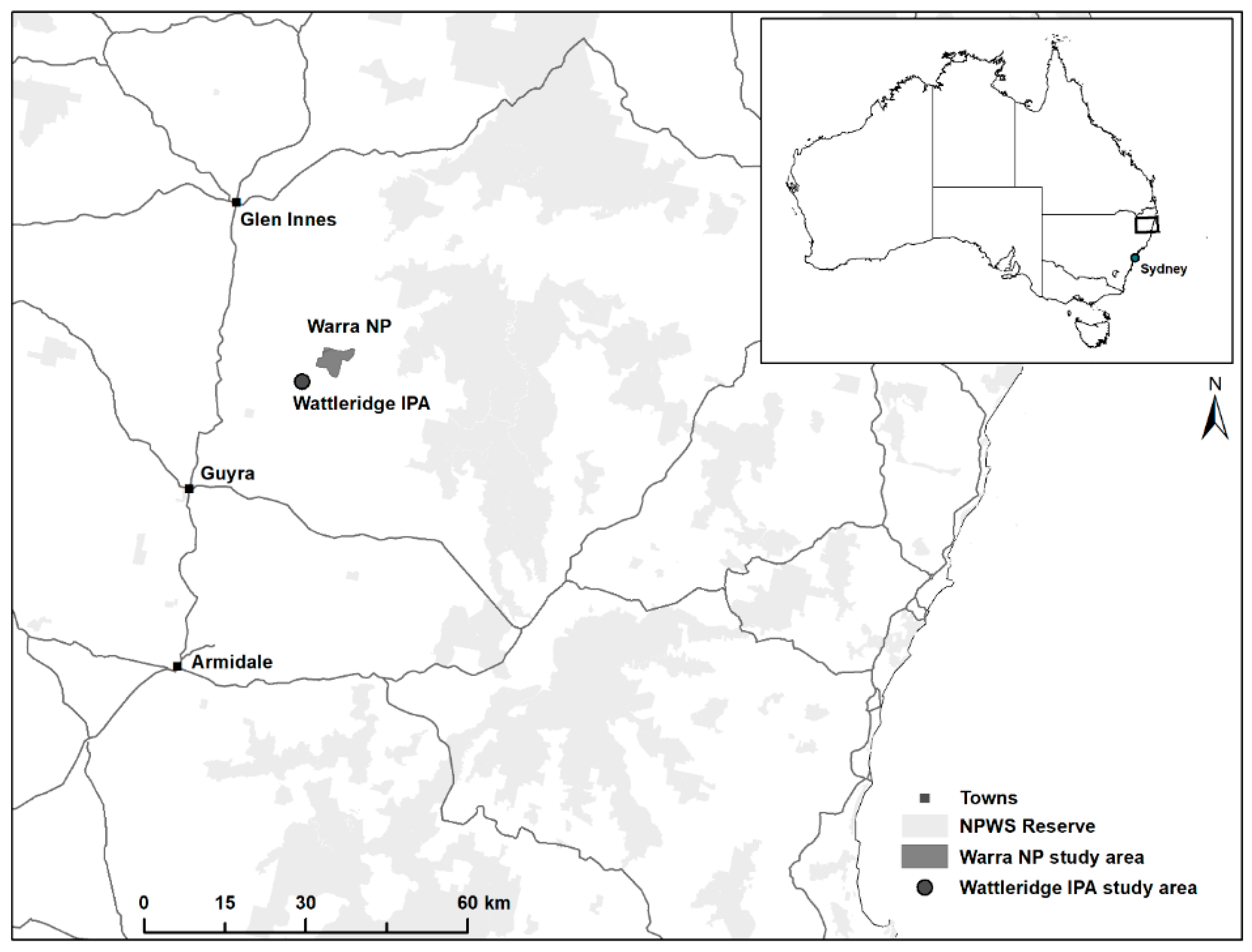
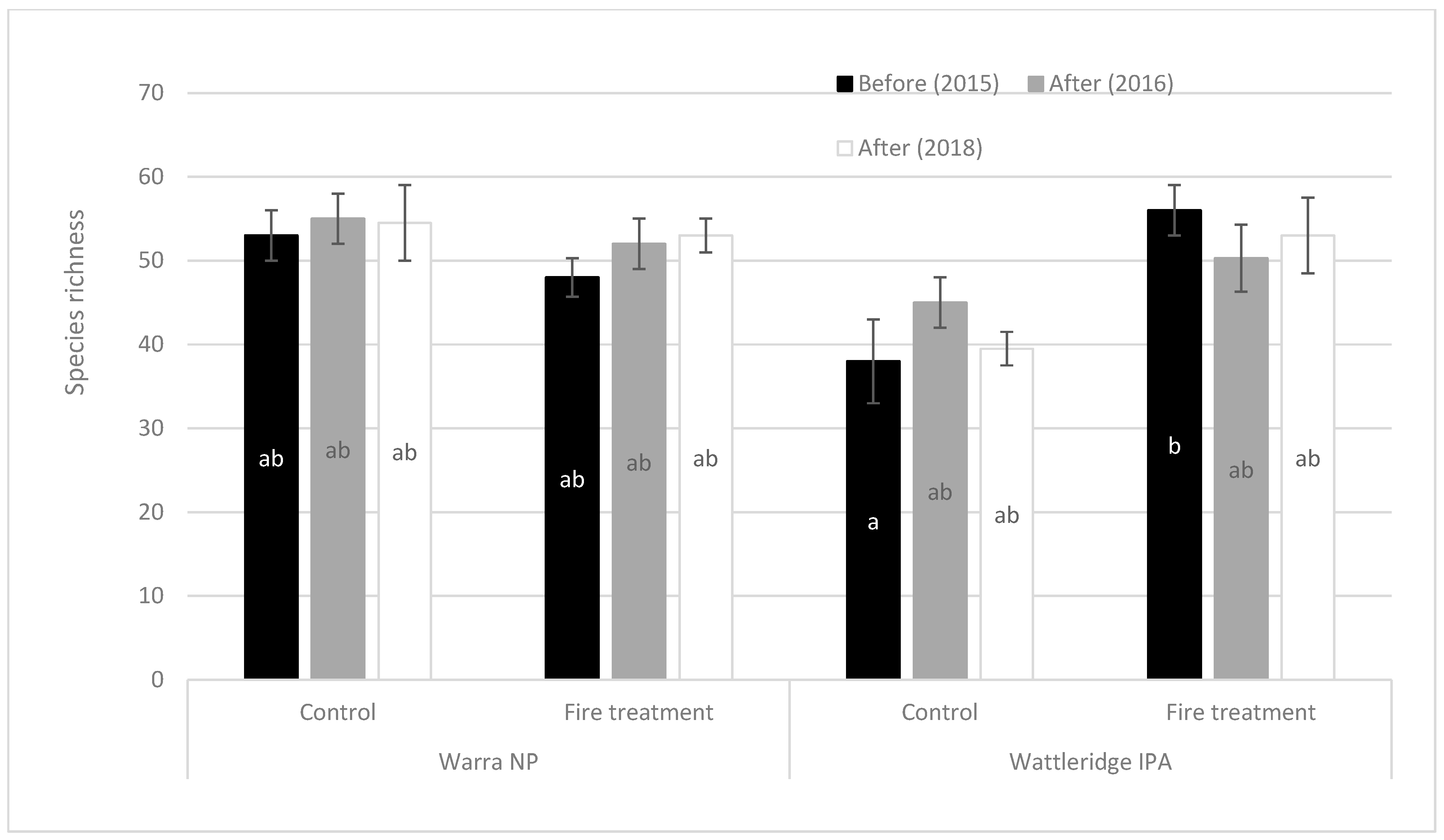
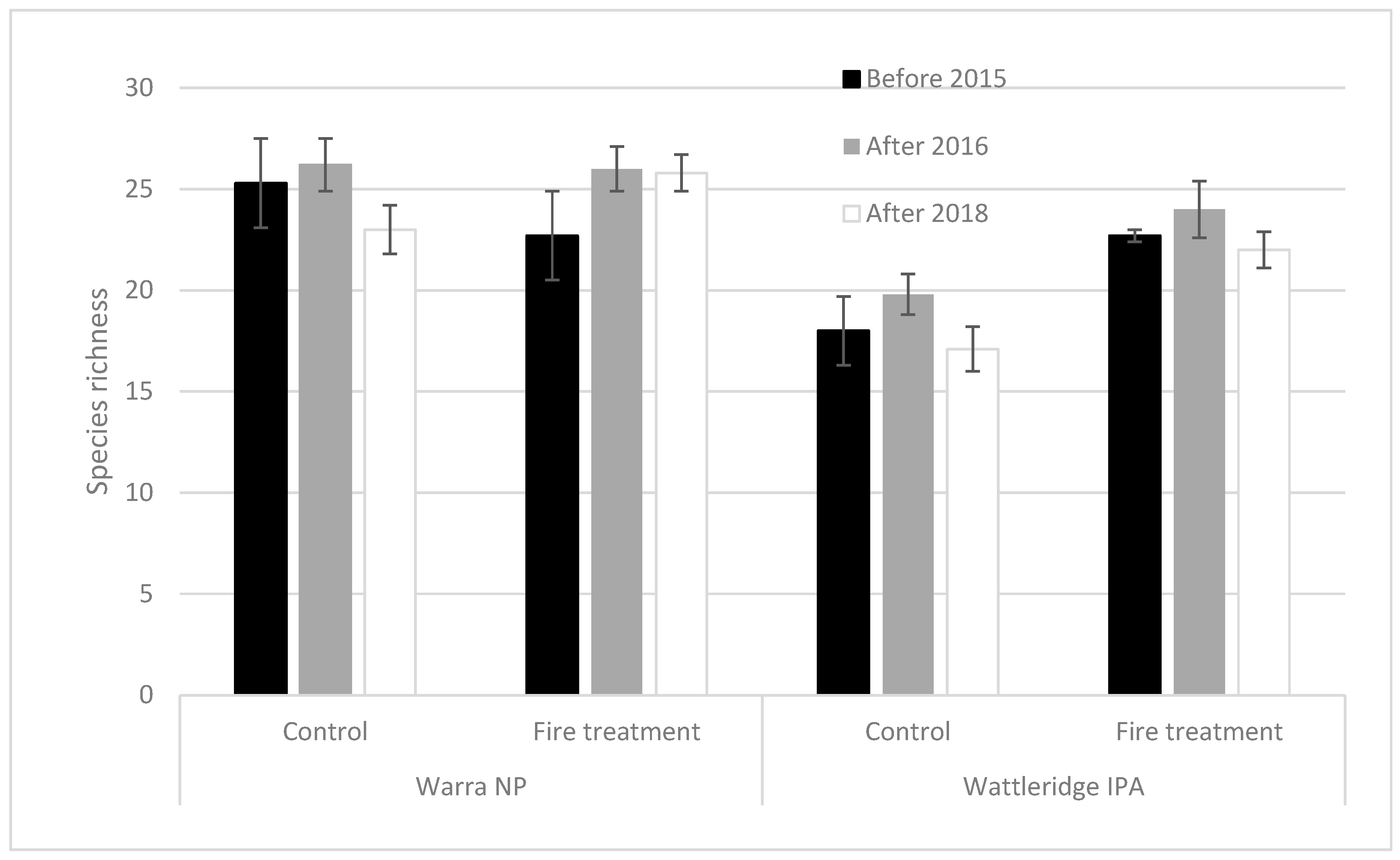
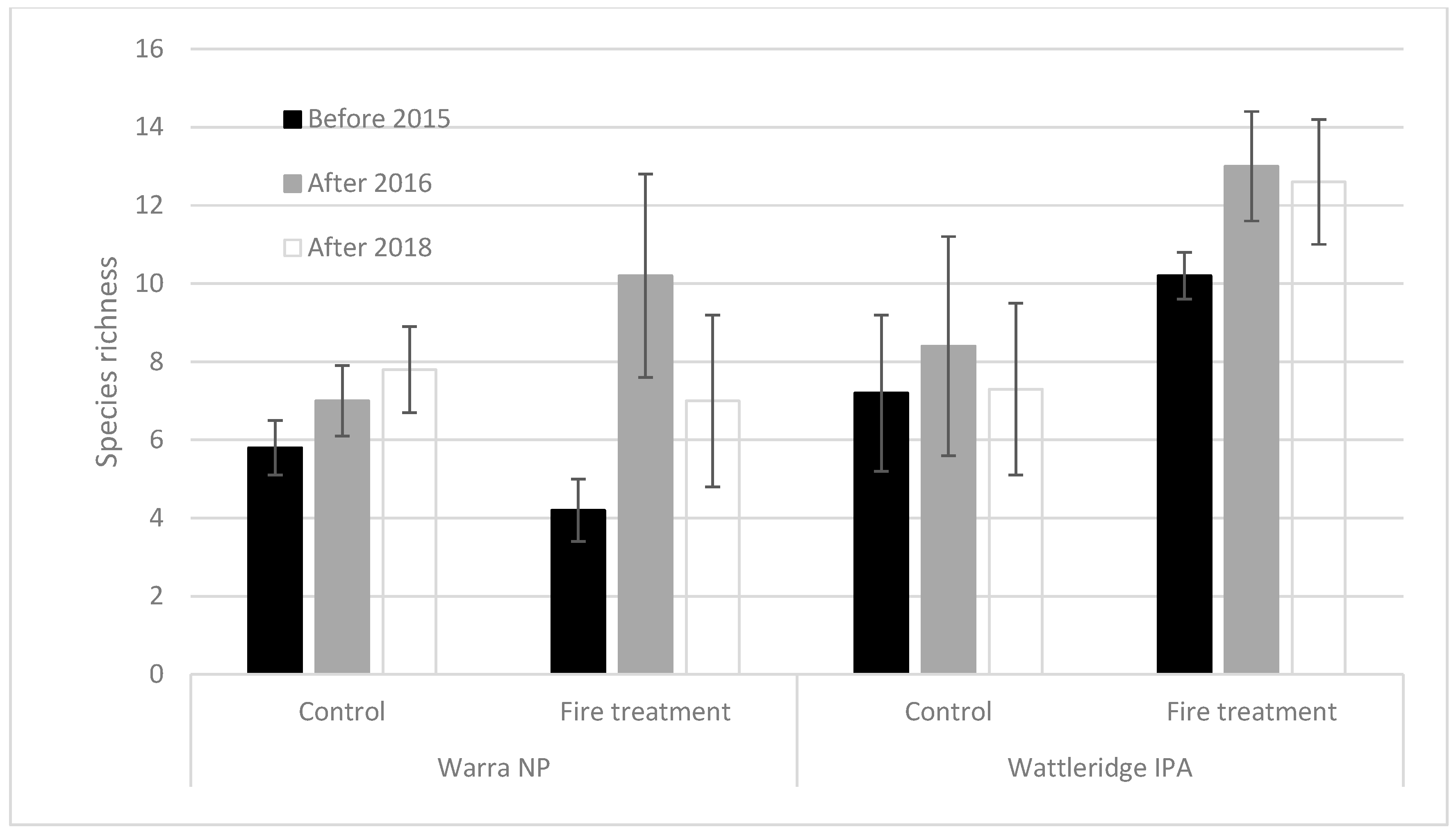
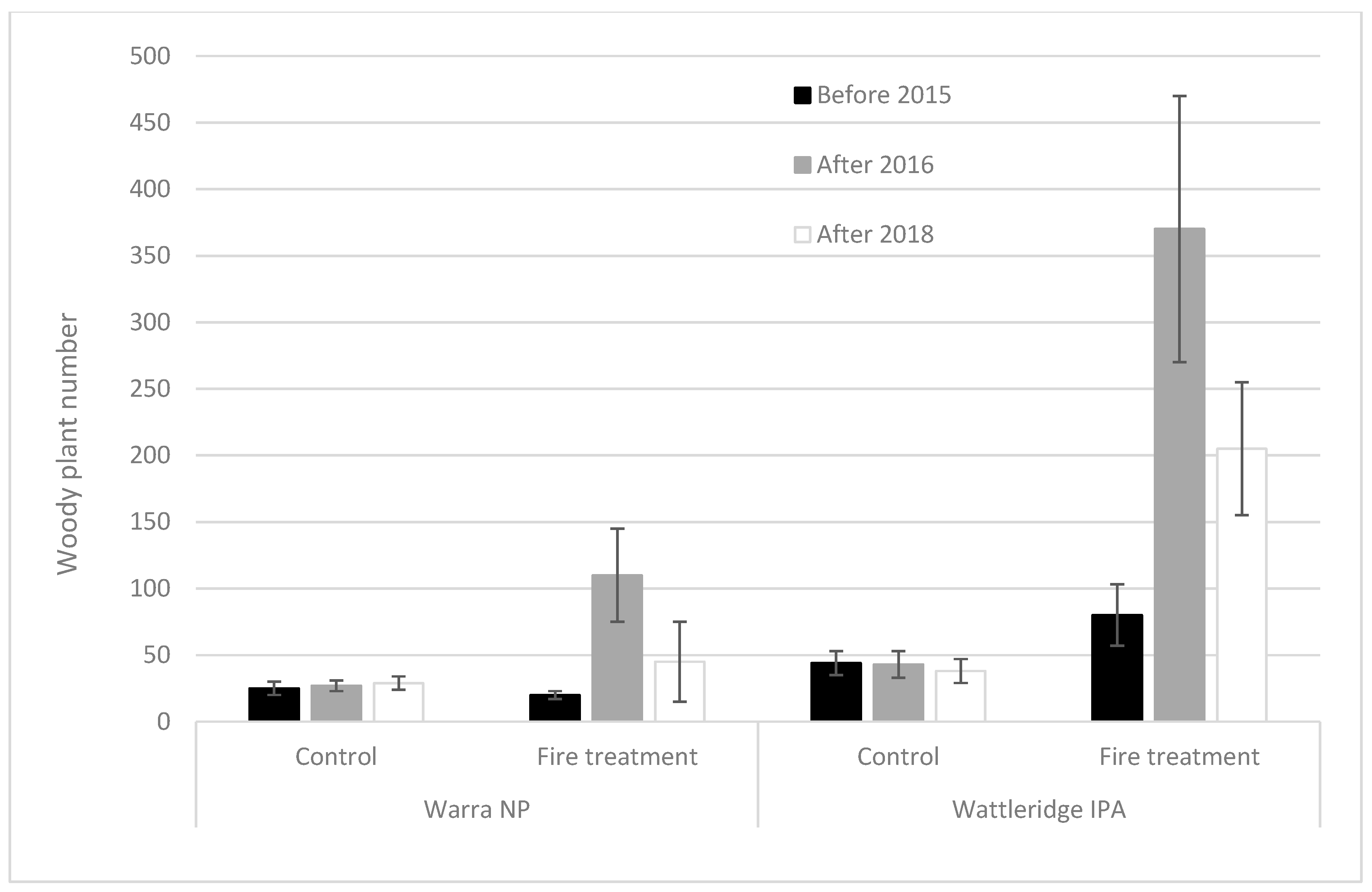
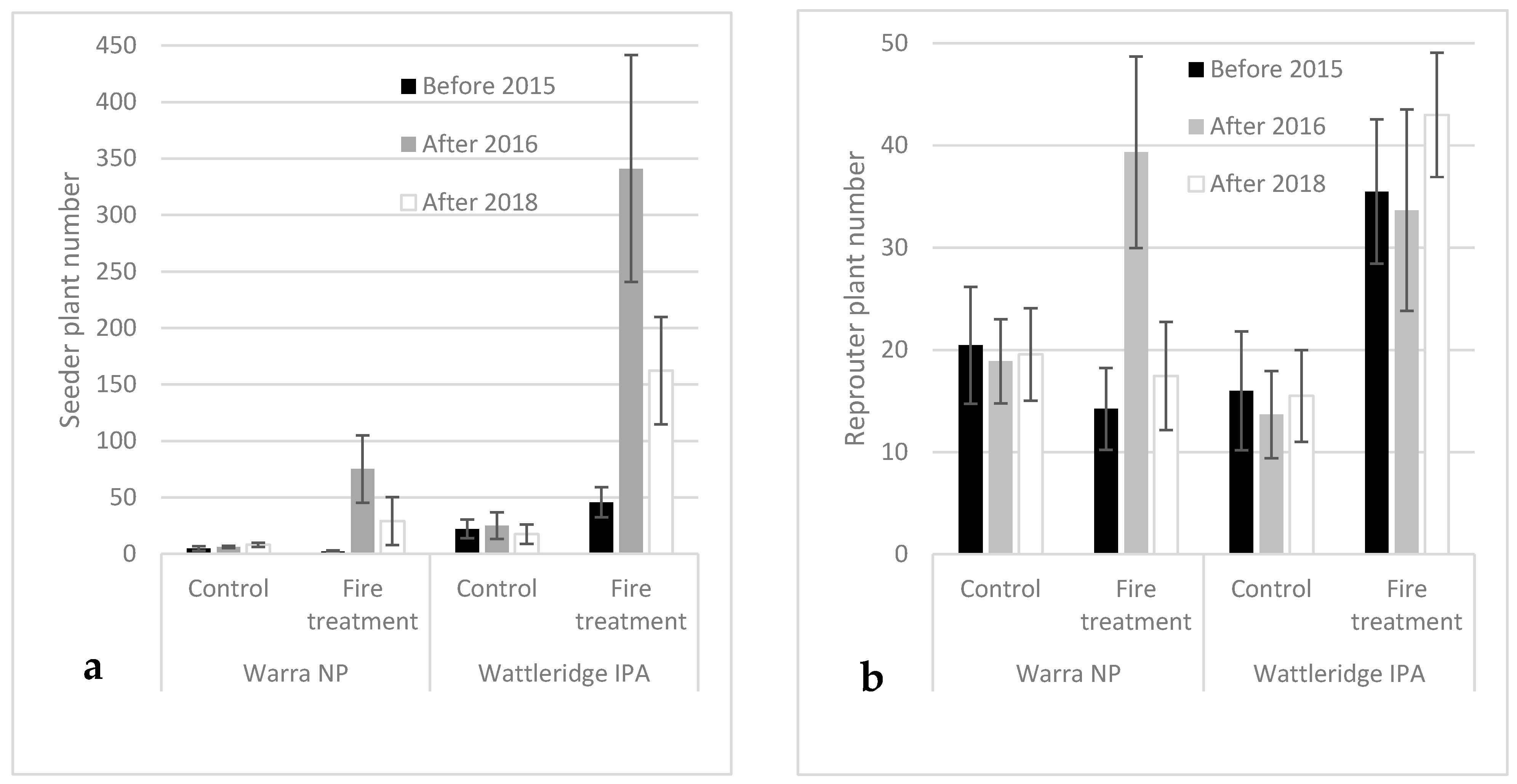
| Wattleridge IPA—All Plots | Warra NP—Impact Plots | Warra NP—Control Plots | |
|---|---|---|---|
| Time since last large fire | 30 years | 16 years | 14 years |
| Number of fires that had affected plots 1990–2015 | 0 | 2 | 3 |
| Total number fires on property 1990–2015 | 4 | 10 | 10 |
| Prescribed fire threshold 1 | Within threshold | Within lower limit of threshold | Too frequently burnt |
| Indicator | Wattleridge IPA Cultural Burn | Warra NP Hazard Reduction |
|---|---|---|
| Mean fuel load decrease (t/ha) | 8.9 ± 1.59 (6) | 7.8 ± 1.49 (9) |
| Mean tree scar height (m) | 3.8 ± 0.65 (6) | 5.8 ± 1.25 (9) |
| Mean percentage plot burnt (%) | 59 ± 8.0 (6) | 81 ± 5.1 (9) |
| Total fire size (ha) | 4 | 685 |
| Fire plan intensity | Low | Moderate–high |
| Observed intensity | Low | Moderate |
| Estimated crown scorch | 0% | 10% |
| Fire severity | Light | Moderate |
| Plant Taxa | Location | Year | Fire Treatment | Year × Fire Treatment |
|---|---|---|---|---|
| Full floristics | Warra NP | 0.175 | 0.115 | 0.988 |
| Wattleridge IPA | 0.459 | 0.046 * | 0.938 | |
| Herbaceous species | Warra NP | 0.0001 *** | 0.110 | 0.828 |
| Wattleridge IPA | 0.087 | 0.101 | 0.978 | |
| Shrubs and juvenile trees (<2 m high) | Warra NP | 0.02 * (2015 v 16 = 0.003 *) | 0.031 * | 0.353 (Impact plots, 2015 v 16 = 0.002 *) |
| Wattleridge IPA | 0.983 | 0.014 * | 0.975 |
| Plant Taxa | Response Variable | Location | Year | Fire Treatment | Year × Fire Treatment |
|---|---|---|---|---|---|
| Full floristics | Plot species richness | 0.086 | 0.734 | Overall = 0.005 * (Warra = 0.941, Wattle-ridge = 0.001 *+) | 0.914 |
| Herbaceous species | Plot species richness | 7.93 ×10−6 *** | 0.70349 | 0.02908 * | 0.26153 |
| Shrubs and juvenile trees (<2 m high) | Plot species richness | 5.10 × 10−5 *** | 0.12998 | 0.110 | 0.259 |
| Abundance | 5.786 × 10−10 *** | 0.0001 * | 9.690 × 10−5 *** | 0.0003 *** | |
| Seeder abundance | 7.816 × 10−11 *** | 5.339 × 10−5 *** | 0.0002 *** | 0.0020 ** | |
| Resprouter abundance | 0.0132 * | 0.3002 | +0.0671 | 0.2092 |
Disclaimer/Publisher’s Note: The statements, opinions and data contained in all publications are solely those of the individual author(s) and contributor(s) and not of MDPI and/or the editor(s). MDPI and/or the editor(s) disclaim responsibility for any injury to people or property resulting from any ideas, methods, instructions or products referred to in the content. |
© 2025 by the authors. Licensee MDPI, Basel, Switzerland. This article is an open access article distributed under the terms and conditions of the Creative Commons Attribution (CC BY) license (https://creativecommons.org/licenses/by/4.0/).
Share and Cite
McKemey, M.; Hunter, J.T.; Patterson, M.; Simpson, I.; Reid, N.C.H. Impacts of Indigenous Cultural Burning Versus Hazard Reduction on Dry Sclerophyll Forest Composition, Abundance, and Species Richness in Southeast Australia. Fire 2025, 8, 367. https://doi.org/10.3390/fire8090367
McKemey M, Hunter JT, Patterson M, Simpson I, Reid NCH. Impacts of Indigenous Cultural Burning Versus Hazard Reduction on Dry Sclerophyll Forest Composition, Abundance, and Species Richness in Southeast Australia. Fire. 2025; 8(9):367. https://doi.org/10.3390/fire8090367
Chicago/Turabian StyleMcKemey, Michelle, John T. Hunter, Maureen (Lesley) Patterson, Ian Simpson, and Nick C. H. Reid. 2025. "Impacts of Indigenous Cultural Burning Versus Hazard Reduction on Dry Sclerophyll Forest Composition, Abundance, and Species Richness in Southeast Australia" Fire 8, no. 9: 367. https://doi.org/10.3390/fire8090367
APA StyleMcKemey, M., Hunter, J. T., Patterson, M., Simpson, I., & Reid, N. C. H. (2025). Impacts of Indigenous Cultural Burning Versus Hazard Reduction on Dry Sclerophyll Forest Composition, Abundance, and Species Richness in Southeast Australia. Fire, 8(9), 367. https://doi.org/10.3390/fire8090367






